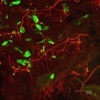Julie Jacobs


EDUCATION:
M.S. Neuroscience, The Univ. of Iowa
current Position:
Research Assistant III/Lab
Manager
Contact:
More IMAGEs of my work




Characterization of the smetana mutant




The smetana mutation was localized to chromosome 2L via deficiency mapping. A variety of methods were then used to narrow the region to three candidate genes - Tsp39D, CG31623, and FTDH.
Compared to heterozygous flies, those carrying the smetana allele over deficiency are completely deaf when tested with our electrophysiology paradigm.
Schematic of the smetana region of interest showing the relationship of candidate genes to P-element insertions and deficiency lines.
One full length and 2 overlapping genomic rescue constructs were engineered via recombineering. These were independently injected into wild type embryos to generate stable transformant lines. Each was then tested for the ability to rescue the mutant (deaf) phenotype. Based on the rescue results, the smetana mutation was determined to lie within the CG31623 locus.
Only the full length and left segment rescue constructs were able to rescue the smetana mutant phenotype.
As further confirmation, a UAS-RNAi construct targeted against CG31623 phenocopied the smetana mutant phenotype when expressed in antennae using a strong ubiquitously expressed Gal4 line.
Electrophysiology of flies expressing a smetana RNAi construct shows a dramatic reduction in hearing.
The smetana mutant was recovered from an EMS mutagenesis experiment. Antennae of smetana flies fail to transduce sound. Additionally, these mutants are somewhat sedentary and males are sterile.
Additional experiments have (1) confirmed rescue of CG31623 using a heat shock Gal4 driven smetana cDNA; (2) shown expression of smetana protein in antennae; and (3) exhibited UAS-GFP expression in antennae and testes when driven with a Gal4 construct containing the upstream regulatory region of CG31623 (not shown).
Detailed sequencing has demonstrated that the smetana phenotype results from a single base pair mutation in CG31623. Current experiments are directed at further characterization of smetana, its function in the scolopidium, and its interacting partners.
